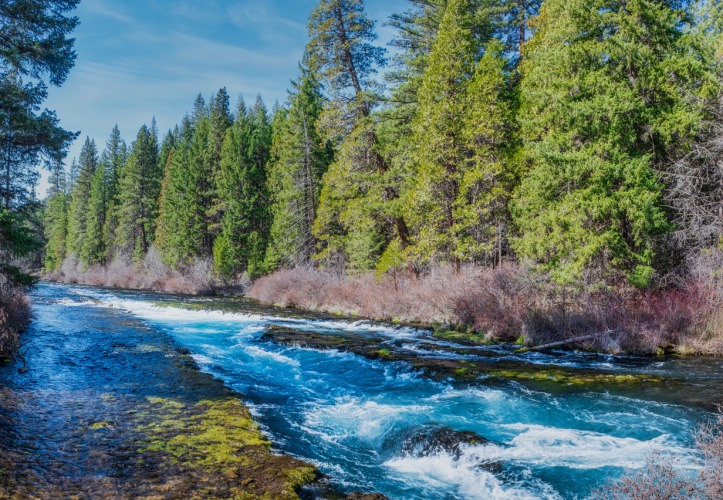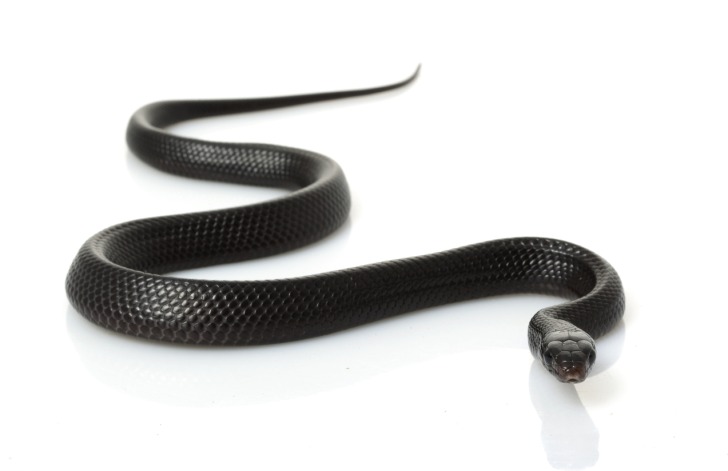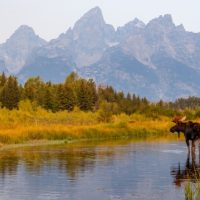There are 15 known species of snakes in Oregon, and only one is venomous and dangerous to humans.
The Western Rattlesnake can be found in many parts of the state, but your chances of running into one are pretty slim.
You can enjoy the outdoors in Oregon without much concern about snakes.

Contents
So… Are There Snakes in Oregon?
Yes, there are snakes in Oregon.
There are several kinds of snakes, including the Western Rattlesnake, that are poisonous.
There are two or three varieties of rattlesnakes, but the differences are very small.
These are found mostly in the eastern part of the state.
The coastal areas, and some woodlands, have four species of garter snakes, which are relatively small and harmless.
Two more species of garter snakes live in lakes and marshy areas.
They live both in the water and on land, so they are not true water snakes.
There are often more snakes around lakes in Oregon than anywhere else.
Snake Species in Oregon
Western Rattlesnake is the only venomous snake in Oregon, but there are two varieties.
There is the Northern Pacific snake that lives in the eastern part of the state, and the Great Basin Rattlesnake, found in the southeastern part of the state.
The California Mountain King snake is found in the mountainous areas of the state.
It looks a lot like the venomous coral snake but is harmless.
These can live 25 years and get to four feet long.
There are several kinds of garter snakes in Oregon.
The common garter snake is found all over America and is small and harmless.
King Snakes are kept as pets by snake lovers.
They are generally black with white bands but can be brown or gray depending on the subspecies.
The Gopher snake looks like the Pacific Rattlesnake, but it is not venomous.
It can make a sound similar to a rattler and can confuse predators, as well as people.
The Night snake is a bit mysterious because it only comes out at night, and is rarely seen.
They live in many places though, and adapt easily to different environments.
It has fangs and venom, but it is not harmful to humans.
The Ringneck Snake is another one that has fangs and some venom, but it is harmless to humans.
This is another snake that is kept as a pet.
The Rubber Boa is the northernmost boa, as most live in tropical climates.
There is also the brown boa, which is considered a different species.
They tend to stay hidden and come out only at night.
Sharp Tail Snake gets its name from a sharp spine that comes off its tail.
It is a piece of bone it uses to hold prey in place.
These snakes grow to only 18 inches and are harmless to humans.
The Striped Whipsnake gets its name from its stripes that go all the way along its body.
They are thin snakes, and very fast, which is why they are called whipsnakes.
They live in many parts of the state, and while thin, they can grow up to 72 inches long.
Western Ground snakes grow to 19 inches and can have different appearances.
Some have stripes and some have patterns, and they range from orange to brown.
Unlike most snakes, the western ground snake has pupils in its eyes as opposed to slits.
The Western Yellow-Bellied Racer snake can live up to 20 years and grow to eight feet long.
It is a subspecies of the Racer snake.
They can look like other snakes, including a rattlesnake, but they are unique with their yellow belly.
Is it Safe to Go on a Trek in Oregon?
Hiking is very popular in Oregon and, for the most part, it is safe.
There are lots of well-marked trails of various degrees of difficulty.
Some high mountain climbs can be dangerous and should not be tried without experience and proper equipment.
This is probably the most dangerous kind of hiking in Oregon.
There are miles and miles of trails that can be difficult but are not dangerous.
There is very little danger from snakes, though there is one species of rattlesnake to look out for.
That is more in the eastern part of the state, and they will warn you if you are too close.
If you are out in the wilderness, there is probably more danger from a wild animal than there is from a snake.
Falling over a tree or rock is probably the greatest danger.
You could get injured and have a hard time walking.
Some areas near the ocean have high cliffs, which can be dangerous if you are hiking at the top.
The drop is usually sudden, and a fall there could be fatal.
Fortunately, the end of the cliffs is easy to see and avoid.

Interesting Snake Facts in Oregon
The Rubber Boa, or northern boa, is one of the gentlest snakes that exist.
It is used to help people who are afraid of snakes.
Like other boa snakes, it constricts to squeeze and kill its prey.
Its constrictions are not hard enough to harm humans.
The gopher snake will hit a person, or another animal, with its nose as a warning.
It will do this before it bites.
It is not a venomous snake, but the fangs could probably hurt a person.
What is the difference between venomous and poisonous?
Poisonous is something that will hurt you if you eat it or ingest it.
Venom is a poison, but it is injected into a person through a bite by a snake.
3 Safety Tips for Exploring Nature in Oregon
- Look and listen. If you hear rustling beside a trail, or what sounds like movement, it could be a snake. It’s a good idea to keep moving and leave whatever is alone. Snakes like quiet areas and want to stay away from people, so they are not likely to be on a trail.
- Be careful in wild areas. If there is tall grass, use a stick to separate the grass and look for snakes. Most snakes are encountered in wild areas off the trail.
- Avoid large rocks, especially in summer. Snakes often like to lie on rocks to take in the warmth of the sun. A snake will try to get out of your way, but if you step on a snake it may try to bite you.
Summary
There are 15 species of snakes in Oregon, and the Western Rattlesnake is the only one you need to be concerned about.
They tend to stay away from humans as much as they can, so there is not much danger in Oregon from snakes.
Oregon Safety Overview
READ THE FULL REPORT: Oregon Safety Review
Safety Index:
- OVERALL RISK: LOW
- TRANSPORT & TAXIS RISK: LOW
- PICKPOCKETS RISK: MEDIUM
- NATURAL DISASTERS RISK: HIGH
- MUGGING RISK: LOW
- TERRORISM RISK: MEDIUM
- SCAMS RISK: MEDIUM
- WOMEN TRAVELERS RISK: LOW
Frequently Asked Questions
How many snakebites happen in Oregon?
There are 14 snakebites per year in the state on average.
That is less than one person per 100,000 people.
By comparison, New Hampshire averages one, and Texas has about 1400 per year.
Has anyone ever been killed by a snakebite in Oregon?
The last known death from a snakebite in Oregon happened to a farmer in 1991.
Rattlesnakes in Oregon do not produce enough venom to kill a person in most cases.
Only about five people per year die from snake bites in all of America.
What do snakes do in winter?
Snakes bromate, which is similar to hibernating.
They are usually in large groups over winter, and come out in spring.











